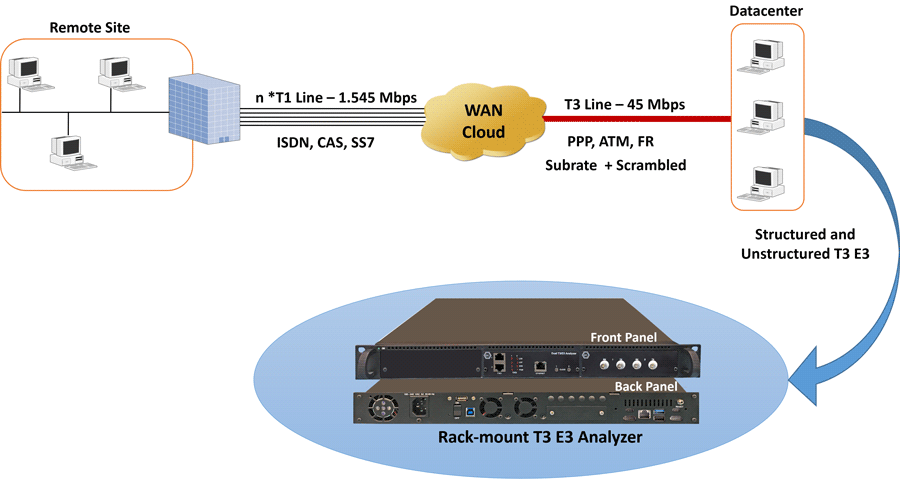T3 E3 Signal Analyzer for Channelized and Unchannelized Applications
Gaithersburg, Maryland, USA - October 18, 2023 - GL Communications Inc., a global leader in telecom test and measurement solutions, addressed the press regarding their T3 E3 Analyzer, a versatile solution designed to monitor and generate traffic over T3 and E3 networks. All timeslots of all constituent T1 and E1 lines can be viewed and controlled. Users can analyze or emulate common telecom protocols including ISDN, CAS and SS7 traversing the T3 E3 networks.

“T3 and E3 network infrastructure remains highly used throughout the modern world. GL's T3 E3 Analyzer is a versatile tool that handles signaling, voice, and data in full T3 (DS3) or E3 data streams. It can drop and insert T1 (DS1) or E1 and analyze HDLC, ATM, Frame Relay, and PPP Protocols. This analyzer is equipped for both Unchannelized (Unstructured) and Channelized (Structured) T3 E3 Traffic”, said Vijay Kulkarni, CEO of GL Communications.
A T3 line can transmit data at speeds up to 44.736 Mbps, while an E3 line operates at 34.368 Mbps within the Plesiochronous Digital Hierarchy (PDH). The channelized option in the T3 E3 Analyzer directly accesses all the channels within a T3 or E3 line, whether it is 2x28 T1s, 2x21 E1s, or 2x16 E1s, allowing for emulation, analysis, and monitoring on a single PC. This includes support for various T1 or E1 framing formats, physical layer alarms, and payloads.
Similar to other GL products, the T3 E3 Analyzer is controlled by a Windows® PC via a USB connection. The software has an easy-to-use Graphical User Interface where users can configure test parameters, start and stop tests and view real time data and graphs. GL also offers T3 E3 probe and rack-mount variants, combining the USB-based T3 E3 Analyzer hardware unit with a Single Board Computer pre-installed with all software and licenses. This setup is ideal for field testing (probe version) or high-density lab testing (rack-mount version).
The T3 E3 hardware platform with associated T1 E1 Send Receive Server and Channelized T3 analyzer software can transmit T1 E1 frames over T3 E3 lines and capture, record, and monitor multiple T1 or E1 channels over Channelized T3 or E3 links. It can perform analysis of various signal types including voice, digits, tones, fax, modem, and raw data.
For more details, refer to Channelized T3E3 Working Principle.
Main Features
- Portable light-weight T3 (DS3)/E3 analysis platforms with dual data stream capture capability
- Multiple interfaces for analysis (T3 (DS3)/E3, T1 E1) to support a wide array of testing scenarios
- Software Selectable T3 (DS3) and E3 interface along with T1 and E1 Drop and Insert
- Dual T3 (DS3) /E3 Receivers and Transmitters for non-intrusive and intrusive testing of both eastbound and westbound signals at the same time
- Flexible clocking - internal, recovered (from T3 E3, T1 or E1) and external
- Scripting and Automation through GL’s Windows Client Server (WCS) approach
- WCS commands can be issued in Python scripts running in Windows® or Linux®
- Includes HDL File Conversation utility to convert ethereal format file (*. pcap, *.cap, and *. pcapng) to GL’s file format (*.hdl) and vice-versa
Unchannelized (Unstructured) Testing
- Analysis and simulation of ATM, PPP, HDLC, and Frame Relay protocols
- Transmit/Verify HDLC frames with user-defined headers
- Support for Scrambling and Subrate with DSU vendors' algorithms for T3 interface, including Digital Link, Larscom, Verilink, and Adtran
Channelized (Structured) Testing
- Drop and Insert Functionality
- Utilizes the Dual T1 E1 ports on the hardware
- Multiplexes and De-multiplexes T1 (DS1)/E1 signals (Drop and Insert)
- Receivers for bidirectional monitoring with Dual T1 (DS1)/E1 drop
- Transmits multiplexed externally inserted or internally generated T1 or E1 streams into T3 (DS3)/E3
- Conducts stress tests on M13 (E13) multiplexers and 3/1 Digital cross-connect systems
- Dual channel drop and insert of T1 or E1 signals from any one of the T3 (DS3)/E3 signals
- Offers options for broadcasting or loopback of individual T1s/E1s received from T3 (DS3)/E3
BIT Error Rate Test (BERT)
- Perform BERT on T3 E3 channels simultaneously
- Support BERT through WCS commands
T1 E1 Tx/Rx Server Software
- Transmit T1 E1 frames over T3 E3 lines using the T1 E1 Transmit Server
- Receive T3 E3 data with the T1 E1 Receive Server, which demultiplexes it into T1 or E1 channels
- Send/Receive 28 T1 Channels per port from T3 signal
- Receive 21 E1 Channels per port (G.747 Mapping) from T3 signal
- Receive 16 E1 Channels per port from E3 signal
- Supports monitoring of framed and unframed T1 E1 (Rx Only)
- Simultaneous analysis of all 56 T1s (1.544 Mbps each) or 32 E1s (2.048 Mbps each)
- Analysis of Fractional T1s and E1s, N x T1s or N x E1s
- Analysis of any combination of DS0s (64 kbps each) within the T1s or E1s, totaling 1,344 DS0s for T1 or 1,024 DS0s for E1
- Supports Protocol Analysis for all structured protocols including HDLC, ISDN, CAS, and more
- Monitors T1 E1 Alarms, Payload, and Framing structure
 Back to Press Releases Index Page
Back to Press Releases Index Page